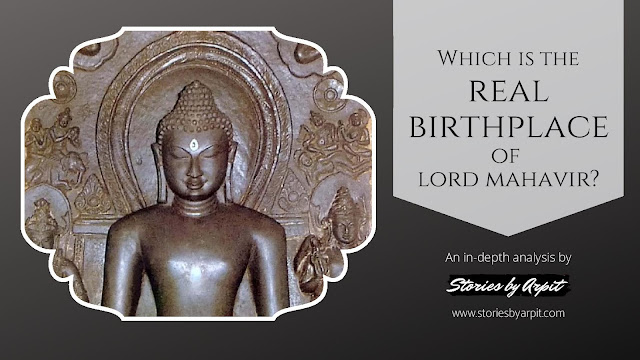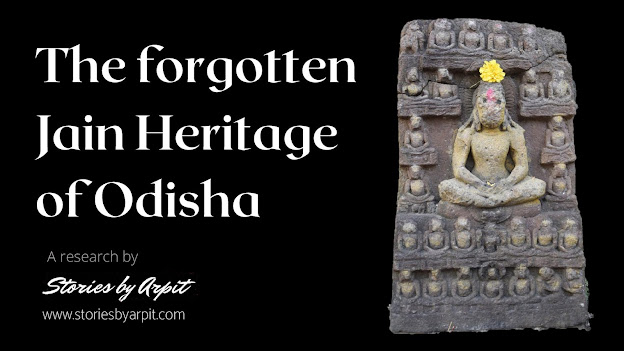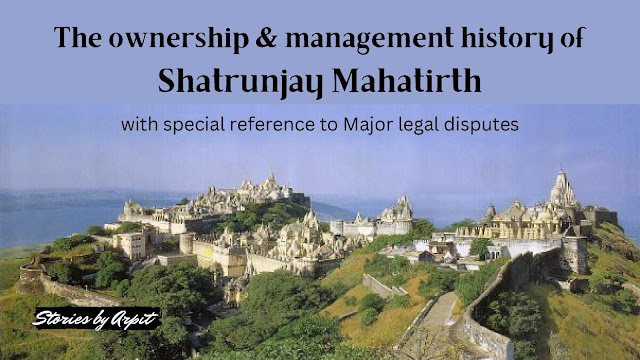In search of the real Pava...

BACKGROUND
Jains have always revered the places where the five divine events, i.e. the Panchkalyanaks of Tirthankars (Chyavan, Janma, Diksha, Kevalgyan and Nirvan) had taken place. The last Tirthankar of this cosmic cycle, Shri Vardhaman Mahavir, on whose teachings Jainism has survived, flourished and thrived till date, was born in 599 BC and attained Nirvan in 527 BC at the age of 72.
As I had also discussed this in one of my earlier blogs, it would be obvious to assume that being the last Tirthankar, all the original locations of Lord Mahavir’s Panchkalyanaks would have been well preserved by Jains; However, the case is not so. Although, it might be surprising, the locations of all the five Kalyanaks of Lord Mahavir are disputed – either between the Shwetambar-Digambar sects or by history scholars.
The only Kalyanak location agreed by both the Shwetambar & Digambar sects, i.e. Pavapuri (near Nalanda in Bihar) is disputed by history scholars, who place the location of the Nirvan Kalyanak at Pava-Padrauna in Uttar Pradesh.
|
Name |
Location |
Believed by |
|
Pavapuri |
Nalanda Dist. Bihar |
Shwetambars & Digambars |
|
Pava-Padrauna |
Kushinagar Dist. Uttar Pradesh |
Eminent scholars namely Dr. Herman Jacobi, Dr. K.C. Jain, Dr. Sagarmal Jain, Bhagvatiprasad
Khetan among others |
 |
| Pavapuri & Padrauna |
Situated nearly 300 kilometers away from the Nirvan location believed by Jains traditionally (i.e. Pavapuri in Nalanda Dist.), we will try to understand through this post, why these eminent historians consider Padrauna to be the site of actual Pava and whether their conclusions are correct or not. However, before that, let us understand and recall some of the major events which occurred in Pava and literary evidences of Pava in Jain scriptures.
PAVA – MAJOR EVENTS THAT OCCURRED IN LIFE OF LORD MAHAVIR
1. Twelve years after his Diksha, Lord Mahavir arrived at a village named as Chammani (Shadagmani) and stood absorbed in deep meditation. A cowherd left his oxen near him and asked him to keep an eye on them. When he returned, he did not find the cattle and enquired about the same to the Lord. When he received no reply to his persistent queries, he became furious and thrusted pegs made of a hardened grass known as ‘Kash’ in the ears of Lord Mahavir. The cowherd then cut the parts of the grass protruding from the ears of the Lord to make its extraction very difficult. Lord Mahavir bore all the pain patiently and traversed to Pava. When the Lord reached the home of a merchant named Siddharth for Gochari (Bhiksha), an eminent physician named Kharak was also present there. The physician immediately realized from the facial expression of the Lord that he was suffering from acute pain. He requested and persuaded Lord Mahavir to let him extract the pegs and made him sit in a large bowl filled with oil. After giving him a massage to loosen the pegs, he extracted them carefully using pincers. When the pegs were extracted, the pain was so excruciating that even Lord Mahavir cried out in agony. This was the first major event to have occurred in Pava.
 |
| Cowherd torturing Lord Mahavir at Chammani and Kharak removing the Kash pegs at Pava. Painting by Shri Gokuldas Kapadia |
2. Later, in 556 BC, Lord Mahavir attained Kevalgyan (enlightenment) on the banks of Ujjuvalia river (Rujuvalika) in a village named Jrumbhikgram and a Samavasaran was created by the demi-gods. However, his first discourse remained unsuccessful. After crossing 12 yojana’s he reached Pava where the second Samavasaran was created in the garden of Mahasen. After a long discussion on philosophic points, he gave Diksha to 11 Gandhars including Gautam Swami and installed the four-fold Jain Sangh. This was the second major event to have occurred in Pava.
 |
| Lord Mahavir installing the four fold Jain Sangh at Pavapuri. Painting by Shri Gokuldas Kapadia |
3. The last and the most important event in Pava occurred in the year was 527 BC. Lord Mahavir was now 72 years of age, and forty-two years had passed since the beginning of his ascetic life. Realizing that his Nirvan was near, he arrived at Pava, where he spent his last chaturmas in the shed of King Hastipal of Pava. On the dark night of Amavasya (new moon) in the month of Ashvin (Gujarati) / Kartik (Marvadi), the Lord observed a fast for two days – without even taking water – and delivered his longest sermon lasting 48 hours before the four fold sangh which included 9 Malla and 9 Licchavi rulers of 18 republics of Kashi & Koshal regions. All gazed at the Lord of the three worlds, who was seated in the lotus position before them, and drank in his every word. At the dawn of the Amavasya, Lord Mahavir entered into deep meditation, shed all the Aghati Karmas (non-destructive) and withdrew from his physical body; achieving the state of Nirvan (Moksha). When the light of the knowledge was extinguished, the kings lighted earthen lamps while Indra and other demi gods flew down to Pava and conducted the final rites, post which all rushed to have a share of the Lord’s ashes.
 |
| The Nirvan of Lord Mahavir. Painting by Shri Gokuldas Kapadia |
PAVA – THROUGH THE JAIN SCRIPTURES
To begin with, let us examine the details available in ancient texts, which throw some light on the distinctive names of the place of Lord Mahavir’s Nirvan (similar names in different texts not repeated)-
|
Literature |
Sect |
Date of Composition |
Name |
|
Kalpasutra |
Shwetambar |
~4th Century BC |
Majjhima Pava* |
|
Tiloya Pannati |
Digambar |
~1st Century AD |
Pava** |
|
Nirvan Bhakti |
Digambar |
3rd Century AD |
Pavapur |
|
Uttarpuran |
Digambar |
10th Century AD |
Pavapuri |
|
Trishashtishalakapurush Charitra |
Shwetambar |
11th Century AD |
Apapa |
|
Vividhtirthkalp |
Shwetambar |
14th Century AD |
Apapapuri/ Pava/ Madhyampapa |
*The name, “Majjhima Pava” is also mentioned in Shwetambar texts namely, Avashyak churni, Kalpasutra Vrutti.
**The name, “Pava” is also mentioned in Shwetambar texts namely Avashyak Niryukti and Visheshavashyak Bhashya.
The Jain tradition, since ancient times, recognised the location of Pava near Nalanda District in Bihar and has also identified key spots like the Nirvan bhumi (Gaon Mandir), Agni Sanskar Bhumi (Jal Mandir) and the Shasan Sthapna Bhumi (Samavasaran Mandir). Therefore, the question arises that when both the sects are unanimous in locating Pava in Bihar, why do the historians locate Pava at Padrauna in Uttar Pradesh?
WHY DO THE HISTORIANS LOCATE PAVA AT PADRAUNA, UTTAR PRADESH?
1. According to the Kalpasutra, Pava was ruled by King Hastipal whereas Magadha was ruled by Ajatshatru Konik from its capital, Rajgruhi (Rajgir) at the time of Nirvan of Lord Mahavir. The historians state that the distance between Rajgir and Pavapuri was just 20 kilometers and thus the capitals of two independent kingdoms cannot be merely 20 kilometers apart.
2. Further, the historians state that even if these capitals were so close, Ajatshatru Konik should have been present at the time of Nirvan, as he was a great devotee of Lord Mahavir. However, none of the scriptures mention his presence at the time of Nirvan. Kalpasutra specifically states that 9 Malla rulers and 9 Licchavi rulers of 18 Republics (Gana-Rajya) of Kashi Koshal were present at Pava at the time of Nirvan of Lord Mahavir. While these 18 rulers were on friendly terms with each other, they were in war with Ragruhi (Rajgir) which was a monarchy and not a republic; Thus they wouldn’t have risked coming so close to Magadh empire’s capital Rajgruhi.
3. Apart from the the Jain texts, references of Pava can be found in Buddhist scriptures as well. Literary evidences as in the Buddhist scriptures show that Pava was ruled by the Mallas and was close to Kushinagar (at a distance of 3 Gyuti’s). Digha Nikaya, a Buddhist text from the Pali Canon (~4th century BC- 1st century BC) states that Pava was Gautam Buddha’s last stop before his Nirvan at Kushinagar. The text states that Gautam Buddha walked from Bhognagar to Pava where he had his last meal in the house of Cunda. From Pava, Buddha journeyed on to Kushinagar (crossing the Kakkuttha River on the way) where he attained Parinirvan. A stupa was built at the place where Cunda's house used to be. This stupa was excavated in 1814 by the Archaeological Survey of India at the town of Padrauna which is situated 15 kilometres from Kushinagar in Uttar Pradesh marking the site of ancient Pava. (Note: Buddhist texts also record Lord Mahavir’s Nirvan at Pava in their texts namely Majjhim Nikaya and Digha Nikaya which also state that Pava was in the Malla territory.)
 |
| Buddhist stupa marking the site of ancient Pava, where Buddha had his last meal before his Parinirvana at Kusinagar (Source: Wikimedia Commons) |
4. Excavations at the outskirts of Padrauna have revealed three Jain idols, possibly of Lord Mahavir and Lord Neminath from 6th-7th Century AD which shows the antiquity of Jainism in Pava-Padrauna.
 |
| Jain idols excavated at Pava-Padrauna |
5. Chinese traveler Hiuen Tsang visited India in the 7th Century AD and travelled to various places. He extensively travelled in and around Nalanda, but his records do not mention Pava near its vicinity. However, he recorded the site of Pava near Kushinagar in Uttar Pradesh.
Based on these literary evidences, the historians believe that Hastipal was a Malla King, and ruled from Pava which was one of the 18 republics in the Kashi-Kosal region. Further, Archaeological evidences have given the impetus to the idea that the actual location of Pava is at Padrauna.
ARE THE HISTORIANS CORRECT?
1. After bearing the upsarg (torture) by the Cowherd at Chammani, Lord Mahavir arrived at Pava where the physician named Kharak extracted the ‘Kash’ pegs from the ears of Lord Mahavir. Chammani has been identified as Chaman village in the Bihar Sharif District of Bihar. The distance between these two places and the two locations of Pava is as below-
Based on these literary evidences, the historians believe that Hastipal was a Malla King, and ruled from Pava which was one of the 18 republics in the Kashi-Kosal region. Further, Archaeological evidences have given the impetus to the idea that the actual location of Pava is at Padrauna.
ARE THE HISTORIANS CORRECT?
1. After bearing the upsarg (torture) by the Cowherd at Chammani, Lord Mahavir arrived at Pava where the physician named Kharak extracted the ‘Kash’ pegs from the ears of Lord Mahavir. Chammani has been identified as Chaman village in the Bihar Sharif District of Bihar. The distance between these two places and the two locations of Pava is as below-
We can clearly observe that the distance of Chaman is much closer to Pavapuri in Nalanda district than Padrauna.
 |
| Map showing locations of Chamman, Pavapuri and Padrauna |
2. After attaining Kevalgyan at Jrumbhikgram on the banks of Ujjuvalia river (Rujuvalika), Lord Mahavir travelled 12 yojan's to Pava (1 yojan = 12-15km) in the same evening and installed the four fold Jain Sangh, the very next day at Pava. Therefore, we can very well understand that Pava was around 160 km from Jrumbhikgram.
There are different viewpoints regarding the current location of Jrumbhikgram. While Shwetambars believe it to be at Jamak Village, near Katwaldih (Giridih District, Jharkhand) on the banks of Barakar river, Historians believe that the current location of Jrumbhikgram is at Jamui (Bihar) on the banks of Barnar river. Now let us study the distance between these two places and the two locations of Pava-
We can clearly observe that the distance of both the locations believed to be Jrumbhikgram is closer to Pavapuri in Nalanda district than Padrauna (which is nearly three times the distance).
 |
Map showing locations of Jamak, Jamui, Pavapuri and Padrauna |
3. Traditionally, Jains have believed Pavapuri to be the Nirvan place of Lord Mahavir based on the following identifications-
a. Ancient Stupa in the Samavasaran Mandir compound- This ancient domed stupa is believed to be the site of the Samavasaran where Lord Mahavir installed the four-fold sangh as well as where he gave his last sermon. Although there are no inscriptions on the Stupa, it is traditionally believed to be built by Nandivardhan, Lord Mahavir’s brother. The brick style of the stupa (which can be seen from some places where the plaster has peeled off) resembles that of Buddhist brick stupas and thus very ancient.
 |
| The Ancient stupa structrure beneath the marble canopy |
b. The Jal Mandir has been identified as the site where Lord Mahavir’s Agni-Sanskar (funerary rites) took place. Today, the temple is situated in the middle of an 84-acre pond, which is believed to have been originated when the demi gods and humans rushed to collect the ashes which led to the creation of a huge pit. The pit was filled with rain water and thus this temple came to be known as Jal Mandir. Ancient footprints traditionally dated to Nandivardhan have been installed in the temple. While there are no idols in the Jal Mandir, the temple management also has an idol of Lord Mahavir in its custody, which was installed by Acharya Abhaydevsuri in 1204 AD as per the inscription on its pedestal.
 |
| Jal Mandir, Pawapuri |
c. The Gaon Mandir has been identified as the place where Lord Mahavir attained Nirvan. The main idol of Lord Mahavir swami was installed in 1589 AD and an inscription in the temple shows that a monk named Shri Jinrajsuri of the Khartargacch lineage renovated the temple during the reign of Mughal Emperor Shah Jahan in 1633 AD. The temple also contains a beautiful set of footprints within a cenotaph which has an inscription dated 1642 AD which mentions the words “Nirvan-bhumi Pavapuri” and “Jin-Praasad-Mul-Sthan” which show that Gaon Mandir was the exact place where Lord Mahavir attained Nirvan.
 |
| The footprints marking the site of Lord Mahavir's Nirvan |
4. Jain scriptures state that Lord Mahavir sent away Gautam Swami to preach to a man named Devsharma in the next village to Pava before his Nirvan. This site has been identified as Gonava, 22 kilometers north of Pavapuri.
5. According to Jain Tirth Sarva Sangrah by Sheth Anandji Kalyanji Pedhi, there were three different cities known by the name of Pava during the time of Lord Mahavir. One was situated in the north near Kusinagar (Uttara Pava), and one in south near Hazaribagh (Dakshina Pava). In middle of these two was the city of Pavapuri was known as Majjhima Pava or Madhyama Pava, which meant the ‘middle’ Pava. The name “Majjhima Pava” is stated in Kalpasutra, Avashyak churni, Kalpasutra Vrutti while Vividhatirthkalp gives the name “Madhyampapa”.
 |
| Map showing locations of the three Pavas of Ancient India |
~~~~~~
Based on the above discussions, we can arrive at a conclusion that the Pava mentioned by the Buddhists is actually the Uttara Pava which led the historians to believe that Padrauna is the Nirvan bhumi of Lord Mahavir. Although some questions remain unanswered, we can easily conclude that Pavapuri near Nalanda as believed traditionally by the Jains to be the actual site of Nirvan of Lord Mahavir Swami.
OTHER RELEVANT POSTS
If you liked this post, do also read:












Well Explained with detailing..... Thanks
ReplyDeleteBrilliant and well researched . Great work. Keenly following your great work !
ReplyDeleteThank you so much!
DeleteGreat job keep it up.
ReplyDeleteThank you!
DeleteArpit ji, well researched article. 🙏 *mdr*
ReplyDeleteThank you so much!
DeleteRespect Arpitbhai
ReplyDeleteWould like to meet you and learn from you one day.
Following you since a while on Twitter.
And I don't think if anyone else from Shwetambar Parampara has done this kind of research.
Thank you so much for your kind words Sanyam ! I myself have a lot to learn :)
DeleteVery good article, nice research done by you Arpit. Keep up the good work
ReplyDeleteGreat Explanation and detailing. Your work is inspiring, especially in today's world where the lack of scientific reasoning can leave the next generation detached. Hope we have more people like you working in this field of research and dissemination !
ReplyDelete👏
ReplyDeleteAt which place Mahavir Jain gave 1st sermon? Please tell both ancient and modern names.
ReplyDeleteAfter attaining Kevalgyan Prabhu Mahavir gave his first sermon at Jrumbhikgram. As per Shwetambars the current location of Jrumbhikgram is Jamak (Katwaldih, Jharkhand) whereas as per Digambars the current location is Jamui (Bihar)
DeleteWell researched article !!
ReplyDelete